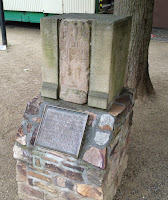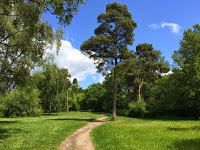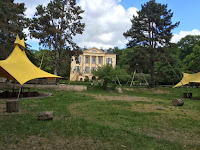Via the absorbing and infinitely intrepid (check out their regular round-ups on newsworthy oddities) Weird Universe comes this personal appeal from mentalist the Amazing Kreskin, courting the idea of forming a supernatural dating pool of lonely hearts.
Wednesday 27 May 2015
paramour or self-fulfilling prophesy
catagories: 🖖, 🧠, lifestyle, myth and monsters
Tuesday 26 May 2015
five-by-five
 free-hand: reflections on the loss of penmanship and learning cursive
free-hand: reflections on the loss of penmanship and learning cursive
dusk-jacket: book covers by Edward Gorey
acuity: Wolfram Alpha website that can identify any image that’s sent its way
tagged: seniors in Portugal grow wise to street art
escape-pods: Slovakian architects conceptualise self-sufficient ecocapsules that could be deployed any where
catagories: 🎓, 💡, 📐, environment, lifestyle
innocents abroad oder entlang der neckartal
 For the long-weekend, though a bit wary of weather that appeared a little dodgy, we decided to stay relatively close to home and visited a portion of the Neckar river valley, going along portions of the tour that Mark Twain helped to retain their character and inchoate charm in his travelogue of Europe on a steam-powered pilgrimage to the Holy Land called The Innocents Abroad —though I’d argue that the area does so despite this notoriety.
For the long-weekend, though a bit wary of weather that appeared a little dodgy, we decided to stay relatively close to home and visited a portion of the Neckar river valley, going along portions of the tour that Mark Twain helped to retain their character and inchoate charm in his travelogue of Europe on a steam-powered pilgrimage to the Holy Land called The Innocents Abroad —though I’d argue that the area does so despite this notoriety.
 Although H and I quite fancy ourselves sophisticates, we saw and learned quite a lot that we thought—between the two of us, we were familiar with.
Although H and I quite fancy ourselves sophisticates, we saw and learned quite a lot that we thought—between the two of us, we were familiar with.
The spare pair of days really telescoped themselves well to feel like a fully-fledged vacation just after we left the Autobahn at a curious place called Bad Wimpfen, with its medieval watch tower dominating the one-time imperial city of half-timbered (Fachwerk) buildings.
 The market and spa town that grew up on the edge of the Roman world, the Odenwald Limes, was swapped between Frankonia, Hessen, Greater Hesse, Baden, Würrtemberg-Baden and then finally the modern state of Baden-Würrtemberg after it lost its imperial immediacy that meant that Bad Wimpfen was a city-state.
The market and spa town that grew up on the edge of the Roman world, the Odenwald Limes, was swapped between Frankonia, Hessen, Greater Hesse, Baden, Würrtemberg-Baden and then finally the modern state of Baden-Würrtemberg after it lost its imperial immediacy that meant that Bad Wimpfen was a city-state.


 Afterwards, we took a leisurely drive, hugging close to the Neckar, between high cliffs, alternately thickly forested or cultivated as vineyards. For all the scenic beauty of the valley, it was strange that one could only capture it from on high—in sweeping vistas. H and I climbed next to Burg Guttenberg in Haβmersheim (I remember this because quite soon, the names of places veered decidedly less creative—all called Neckar- this or that—and kind of ran together) with its imposing late Middle Ages fortifications. The peasants were preparing for a jousting display but when such festivities weren’t underway, the castle was known as a regional centre for falconry.
Afterwards, we took a leisurely drive, hugging close to the Neckar, between high cliffs, alternately thickly forested or cultivated as vineyards. For all the scenic beauty of the valley, it was strange that one could only capture it from on high—in sweeping vistas. H and I climbed next to Burg Guttenberg in Haβmersheim (I remember this because quite soon, the names of places veered decidedly less creative—all called Neckar- this or that—and kind of ran together) with its imposing late Middle Ages fortifications. The peasants were preparing for a jousting display but when such festivities weren’t underway, the castle was known as a regional centre for falconry.
 Burg Guttenberg was on the opposite bank of the Neckar, facing Burg Horneck, a castle of the Teutonic Knights and just a little further on we came to the impeccably preserved playground called Burg Hornburg above the village of Neckarzimmern. The park consisted of a wine-cellars, hotel (where Twain stayed) and restaurant, naturally—and the estate has been in the same noble family for many generations, the friendly attendant and sommelier addressing another gentleman who stopped by as “Herr Baron”—but also an impressive ruin to explore and climb higher and higher.
Burg Guttenberg was on the opposite bank of the Neckar, facing Burg Horneck, a castle of the Teutonic Knights and just a little further on we came to the impeccably preserved playground called Burg Hornburg above the village of Neckarzimmern. The park consisted of a wine-cellars, hotel (where Twain stayed) and restaurant, naturally—and the estate has been in the same noble family for many generations, the friendly attendant and sommelier addressing another gentleman who stopped by as “Herr Baron”—but also an impressive ruin to explore and climb higher and higher.

 We found a campsite in a nearby village of Binau right on the banks of the river.
We found a campsite in a nearby village of Binau right on the banks of the river.
It was a nice place to rest for the evening but—and I suppose no one wants this in their backyard, seeing the nuclear power plant (Atomkraftwerk, AKW) Obrigheim just in the distance was a little off-putting. The next day, we cruised further along the river, past Neckargerach and Zwingenburg, and on to the small town of Eberbach with its massive cathedral set against the highest summits of the Odenwald. Another place mentioned in the whistle-stop tour was Burg Hirschhorn, another well-preserved castle with a playground. Next, H and I visited the village of Neckarsteinach.

This heavily fortified and guarded town on one of the most formerly strategic and contested bends of the river is the southern-most projection of Hessen, and today forms quite the picturesque spot.
 Four castles (die Vierburgenstadt as its known) cling to the ridges above the river valley and on the promenade, we were able to frame three of them in one shot. We camped between Neckargemünd and the outskirts of Heidelberg—probably Twain’s most celebrated destination but one which we’d both knew quite well and worth a future trip of its own.
Four castles (die Vierburgenstadt as its known) cling to the ridges above the river valley and on the promenade, we were able to frame three of them in one shot. We camped between Neckargemünd and the outskirts of Heidelberg—probably Twain’s most celebrated destination but one which we’d both knew quite well and worth a future trip of its own.
 The next day we passed through the storied city and quit the path following the Neckar to tour the palatial grounds of the massive gardens of Schwetzingen, nestled between the branches of the river.
The next day we passed through the storied city and quit the path following the Neckar to tour the palatial grounds of the massive gardens of Schwetzingen, nestled between the branches of the river.
The summer residence of the court of the Palatinate Electors, the rococo architecture and landscape is the German kingdom’s version of Versailles.

 Even if the weather had held, it was maybe a little too ambitious to hope to cover all of the garden, with its resplendent sculpture, hedge mazes, menageries and architectural follies—including this “mosque,” there was too much to see in one afternoon. We could see the rain clouds advancing and hurried back to Lady. We’ll come back to see more one day soon, and some day perhaps repeat Mark Twain’s whole grand tour, making it our own.
Even if the weather had held, it was maybe a little too ambitious to hope to cover all of the garden, with its resplendent sculpture, hedge mazes, menageries and architectural follies—including this “mosque,” there was too much to see in one afternoon. We could see the rain clouds advancing and hurried back to Lady. We’ll come back to see more one day soon, and some day perhaps repeat Mark Twain’s whole grand tour, making it our own.
Friday 22 May 2015
memes, memeplexes and neurath’s boat
Via the dazzlingly peripatetic Nag on the Lake, comes a look at ISOTYPEs—that is International System of Typographic Picture Education, which sounds so much better than the term infographic, which shall be evermore banished.
 I am grateful for learning about these brilliant, vintage diagrams as I had previously discovered the sleek and singular icon libraries of Gert Arntz but had not realised that there was a direct link and application in the educational materials of philosopher Otto Neurath of the Vienna Circle. Like the Ship of Theseus, Neurath’s boat is a paradox to compel one to confront his or her foundational beliefs by dissecting so-called viral memes—those tenants we might identify with but which are recursive and self-serving. Members of the Vienna Circle, formed in the aftermath of World War I, encouraged life-long learning and rigorous self-examination.
I am grateful for learning about these brilliant, vintage diagrams as I had previously discovered the sleek and singular icon libraries of Gert Arntz but had not realised that there was a direct link and application in the educational materials of philosopher Otto Neurath of the Vienna Circle. Like the Ship of Theseus, Neurath’s boat is a paradox to compel one to confront his or her foundational beliefs by dissecting so-called viral memes—those tenants we might identify with but which are recursive and self-serving. Members of the Vienna Circle, formed in the aftermath of World War I, encouraged life-long learning and rigorous self-examination.
gilded placemat
 Although not a surpassingly great technological achievement nor a particularly indemnifying marketing ploy (and I’ll confess I’d never patronise this establishment no matter what the gimmick or give-away), I could not get this taut out of my head—these paper-thin keyboard dining tray inserts so guests can avoid getting grease and crumbs (from a restaurant that built its reputation in part for being messy and lugubrious) on their smart phones. I suppose there’s a little bit of harmless fun to be had here—like with selfie-sombreros and display-cases for one’s more artfully arranged meals, but it does bother me that we’re so ready to admit that we can’t put down our phones even at the table and cannot fix our attention to what’s right in front of us. What do you think? Do we need to be encouraged or enabled any more than we already are?
Although not a surpassingly great technological achievement nor a particularly indemnifying marketing ploy (and I’ll confess I’d never patronise this establishment no matter what the gimmick or give-away), I could not get this taut out of my head—these paper-thin keyboard dining tray inserts so guests can avoid getting grease and crumbs (from a restaurant that built its reputation in part for being messy and lugubrious) on their smart phones. I suppose there’s a little bit of harmless fun to be had here—like with selfie-sombreros and display-cases for one’s more artfully arranged meals, but it does bother me that we’re so ready to admit that we can’t put down our phones even at the table and cannot fix our attention to what’s right in front of us. What do you think? Do we need to be encouraged or enabled any more than we already are?
dozy doats oder extra-sensory
 The village just west of Wiesbaden probably got its name (and crest, a “T”) owing to a count of the court of King Dagobert I called Tuzzo, but the designation Dotzheim was to become an important aristocratic line under the rule of the House of Nassau in its own right and the cast-iron mascots, Dotzi, hung on many of the older buildings at the town centre.
The village just west of Wiesbaden probably got its name (and crest, a “T”) owing to a count of the court of King Dagobert I called Tuzzo, but the designation Dotzheim was to become an important aristocratic line under the rule of the House of Nassau in its own right and the cast-iron mascots, Dotzi, hung on many of the older buildings at the town centre.
 A bit further on (which is why I needed to split up my walk—plus it started to rain) one encounters Schloss Freudenberg—which, for being only built in the early 1900s, has a pretty extensive and complex history. It was completed in 1903 but the youngest castle in Germany dates from 1908, and is included in this collection. The mansion was commissioned by a Scottish post-impressionist painter and his wife but they only lived there a few years—to be later appropriated as a home for expectant mothers and young children of the Lebensborn programme.
A bit further on (which is why I needed to split up my walk—plus it started to rain) one encounters Schloss Freudenberg—which, for being only built in the early 1900s, has a pretty extensive and complex history. It was completed in 1903 but the youngest castle in Germany dates from 1908, and is included in this collection. The mansion was commissioned by a Scottish post-impressionist painter and his wife but they only lived there a few years—to be later appropriated as a home for expectant mothers and young children of the Lebensborn programme. During the course of the war, a garrison was built up on the surrounding gardens near this railhead and was afterwards occupied by the US forces. Freudenberg became an officers’ club and casino until 1973 when it abandoned and fell in disrepair.
During the course of the war, a garrison was built up on the surrounding gardens near this railhead and was afterwards occupied by the US forces. Freudenberg became an officers’ club and casino until 1973 when it abandoned and fell in disrepair. The castle was saved from ruin by a group of adherents to the philosophy of Hugo Kükelhaus, who turned the estate into playground for the senses. Kükelhaus along with his promoted exercising ones perceptions to the fullest in order to hone ones imagination and understanding of the world and eschewed the sanitary, inhuman architecture and design that confined and exhausts by removing those things we are made to feel.
The castle was saved from ruin by a group of adherents to the philosophy of Hugo Kükelhaus, who turned the estate into playground for the senses. Kükelhaus along with his promoted exercising ones perceptions to the fullest in order to hone ones imagination and understanding of the world and eschewed the sanitary, inhuman architecture and design that confined and exhausts by removing those things we are made to feel. Several permanent installations, called experience stations (Erfahrungsfelder), are on display.
 The ongoing renovation project itself is also an extension of Kükelhaus’ beliefs and is therapeutically defined as the combination of healing and art. There is the further objective of educating visitors in abstractions that are independent of the powers of perception (by cultivating and refining one’s physical senses as much as possible) so that they might apprehend what’s just beyond—like dignity and equality.
The ongoing renovation project itself is also an extension of Kükelhaus’ beliefs and is therapeutically defined as the combination of healing and art. There is the further objective of educating visitors in abstractions that are independent of the powers of perception (by cultivating and refining one’s physical senses as much as possible) so that they might apprehend what’s just beyond—like dignity and equality.As well as being the home and headquarters of Hugo Kükelhaus’ movement, Schloss Freundenberg hosts regular seminars and events for kindred organisations and schools of thought. By rushing through I suppose that I was completely missing the point by not playing and discovering fully, but when there is more time, I certainly plan to return and experience all the textures and trapezes.
catagories: 🇩🇪, 🌍, 🎓, 🧠, environment, Hessen, philosophy













